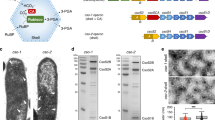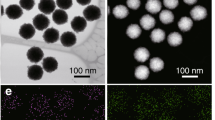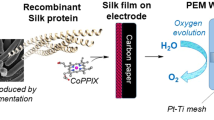Abstract
The chemistry of highly evolved protein-based compartments has inspired the design of new catalytically active materials that self-assemble from biological components. A frontier of this biodesign is the potential to contribute new catalytic systems for the production of sustainable fuels, such as hydrogen. Here, we show the encapsulation and protection of an active hydrogen-producing and oxygen-tolerant [NiFe]-hydrogenase, sequestered within the capsid of the bacteriophage P22 through directed self-assembly. We co-opted Escherichia coli for biomolecular synthesis and assembly of this nanomaterial by expressing and maturing the EcHyd-1 hydrogenase prior to expression of the P22 coat protein, which subsequently self assembles. By probing the infrared spectroscopic signatures and catalytic activity of the engineered material, we demonstrate that the capsid provides stability and protection to the hydrogenase cargo. These results illustrate how combining biological function with directed supramolecular self-assembly can be used to create new materials for sustainable catalysis.
This is a preview of subscription content, access via your institution
Access options
Subscribe to this journal
Receive 12 print issues and online access
$259.00 per year
only $21.58 per issue
Buy this article
- Purchase on Springer Link
- Instant access to full article PDF
Prices may be subject to local taxes which are calculated during checkout





Similar content being viewed by others
References
Tanaka, S. et al. Atomic-level models of the bacterial carboxysome shell. Science 319, 1083–1086 (2008).
Tanaka, S., Sawaya, M. R. & Yeates, T. O. Structure and mechanisms of a protein-based organelle in Escherichia coli. Science 327, 81–84 (2010).
Zhou, Z. H., McCarthy, D. B., O'Connor, C. M., Reed, L. J. & Stoops, J. K. The remarkable structural and functional organization of the eukaryotic pyruvate dehydrogenase complexes. Proc. Natl Acad. Sci. USA 98, 14802–14807 (2001).
Sutter, M. et al. Structural basis of enzyme encapsulation into a bacterial nanocompartment. Nature Struct. Mol. Biol. 15, 939–947 (2008).
Cannon, G. C. et al. Microcompartments in prokaryotes: carboxysomes and related polyhedra. Appl. Environ. Microbiol. 67, 5351–5361 (2001).
Shively, J. M., Ball, F., Brown, D. H. & Saunders, R. E. Functional organelles in prokaryotes: polyhedral inclusions (carboxysomes) of Thiobacillus neapolitanus. Science 182, 584–586 (1973).
Badger, M. R. & Price, G. D. CO2 concentrating mechanisms in cyanobacteria: molecular components, their diversity and evolution. J. Exp. Bot. 54, 609–622 (2003).
Zhang, X. et al. Multiple assembly states of lumazine synthase: a model relating catalytic function and molecular assembly. J. Mol. Biol. 362, 753–770 (2006).
Crichton, R. R. Structure and function of ferritin. Angew. Chem. Int. Ed. Engl. 12, 57–65 (1973).
Vriezema, D. M. et al. Self-assembled nanoreactors. Chem. Rev. 105, 1445–1489 (2005).
Lee, B. Y. et al. Virus-based piezoelectric energy generation. Nature Nanotech. 7, 351–356 (2012).
Kang, S. & Douglas, T. Some enzymes just need a space of their own. Science 327, 42–43 (2010).
Niu, Z. et al. Biological templated synthesis of water-soluble conductive polymeric nanowires. Nano Lett. 7, 3729–3733 (2007).
Nam, K. T. et al. Virus-enabled synthesis and assembly of nanowires for lithium ion battery electrodes. Science 312, 885–888 (2006).
Li, M., Harbron, R. L., Weaver, J. V., Binks, B. P. & Mann, S. Electrostatically gated membrane permeability in inorganic protocells. Nature Chem. 5, 529–536 (2013).
Fiedler, J. D., Brown, S. D., Lau, J. L. & Finn, M. G. RNA-directed packaging of enzymes within virus-like particles. Angew. Chem. Int. Ed. 49, 9648–9651 (2010).
Comellas-Aragones, M. et al. A virus-based single-enzyme nanoreactor. Nature Nanotech. 2, 635–639 (2007).
Wörsdörfer, B., Woycechowsky, K. J. & Hilvert, D. Directed evolution of a protein container. Science 331, 589–592 (2011).
Inoue, T. et al. Engineering of SV40-based nano-capsules for delivery of heterologous proteins as fusions with the minor capsid proteins VP2/3. J. Biotechnol. 134, 181–192 (2008).
Patterson, D. P., Prevelige, P. E. & Douglas, T. Nanoreactors by programmed enzyme encapsulation inside the capsid of the bacteriophage P22. ACS Nano 6, 5000–5009 (2012).
Patterson, D. P., Schwarz, B., Waters, R. S., Gedeon, T. & Douglas, T. Encapsulation of an enzyme cascade within the bacteriophage P22 virus-like particle. ACS Chem. Biol. 9, 359–365 (2014).
Prevelige, P. E., Thomas, D. & King, J. Scaffolding protein regulates the polymerization of P22 coat subunits into icosahedral shells in vitro. J. Mol. Biol. 202, 743–757 (1988).
Parker, M. H., Casjens, S. & Prevelige Jr, P. E. Functional domains of bacteriophage P22 scaffolding protein. J. Mol. Biol. 281, 69–79 (1998).
Weigele, P. R., Sampson, L., Winn-Stapley, D. & Casjens, S. R. Molecular genetics of bacteriophage P22 scaffolding protein's functional domains. J. Mol. Biol. 348, 831–844 (2005).
Lubitz, W., Ogata, H., Rüdiger, O. & Reijerse, E. Hydrogenases. Chem. Rev. 114, 4081–4148 (2014).
Frey, M. Hydrogenases: hydrogen-activating enzymes. ChemBioChem 3, 153–160 (2002).
Buurman, G., Shima, S. & Thauer, R. K. The metal-free hydrogenase from methanogenic archaea: evidence for a bound cofactor. FEBS Lett. 485, 200–204 (2000).
Volbeda, A. et al. X-ray crystallographic and computational studies of the O2-tolerant [NiFe]-hydrogenase 1 from Escherichia coli. Proc. Natl Acad. Sci. USA 109, 5305–5310 (2012).
Lukey, M. J. et al. Oxygen-tolerant [NiFe]-hydrogenases: the individual and collective importance of supernumerary cysteines at the proximal Fe–S cluster. J. Am. Chem. Soc. 133, 16881–16892 (2011).
Krishnan, S. & Armstrong, F. A. Order-of-magnitude enhancement of an enzymatic hydrogen-air fuel cell based on pyrenyl carbon nanostructures. Chem. Sci. 3, 1015–1023 (2012).
Friedrich, B., Fritsch, J. & Lenz, O. Oxygen-tolerant hydrogenases in hydrogen-based technologies. Curr. Opin. Biotechnol. 22, 358–364 (2011).
Volbeda, A. et al. Crystal structure of the O2-tolerant membrane-bound hydrogenase 1 from Escherichia coli in complex with its cognate cytochrome b. Structure 21, 184–190 (2013).
Menon, N. K. et al. Cloning and sequencing of a putative Escherichia coli [NiFe] hydrogenase-1 operon containing six open reading frames. J. Bacteriol. 172, 1969–1977 (1990).
Volbeda, A. et al. Structure of the [NiFe] hydrogenase active site: evidence for biologically uncommon Fe ligands. J. Am. Chem. Soc. 118, 12989–12996 (1996).
Forzi, L., Hellwig, P., Thauer, R. K. & Sawers, R. G. The CO and CN– ligands to the active site Fe in [NiFe]-hydrogenase of Escherichia coli have different metabolic origins. FEBS Lett. 581, 3317–3321 (2007).
Hidalgo, R., Ash, P. A., Healy, A. J. & Vincent, K. A. Infrared spectroscopy during electrocatalytic turnover reveals the Ni–L active site state during H2 oxidation by a NiFe hydrogenase. Angew. Chem. Int. Ed. 127, 7216–7219 (2015).
Menon, N. K., Robbins, J., Wendt, J. C., Shanmugam, K. T. & Przybyla, A. E. Mutational analysis and characterization of the Escherichia coli hya operon, which encodes [NiFe] hydrogenase 1. J. Bacteriol. 173, 4851–4861 (1991).
Dubini, A., Pye, R. L., Jack, R. L., Palmer, T. & Sargent, F. How bacteria get energy from hydrogen: a genetic analysis of periplasmic hydrogen oxidation in Escherichia coli. Int. J. Hydrogen Energy 27, 1413–1420 (2002).
Forzi, L. & Sawers, R. G. Maturation of [NiFe]-hydrogenases in Escherichia coli. Biometals 20, 565–578 (2007).
O'Neil, A., Reichhardt, C., Johnson, B., Prevelige, P. E. & Douglas, T. Genetically programmed in vivo packaging of protein cargo and its controlled release from bacteriophage P22. Angew. Chem. Int. Ed. 50, 7425–7428 (2011).
Hotz, J. & Meier, W. Vesicle-templated polymer hollow spheres. Langmuir 14, 1031–1036 (1998).
Egelhaaf, S. U. & Schurtenberger, P. Shape transformations in the lecithin–bile salt system: from cylinders to vesicles. J. Phys. Chem. 98, 8560–8573 (1994).
Soboh, B. et al. [NiFe]-hydrogenase maturation in vitro: analysis of the roles of the HybG and HypD accessory proteins. Biochem. J. 464, 169–177 (2014).
Murphy, B. J., Sargent, F. & Armstrong, F. A. Transforming an oxygen-tolerant [NiFe] uptake hydrogenase into a proficient, reversible hydrogen producer. Energy Environ. Sci. 7, 1426–1433 (2014).
Hatchikian, E. C., Forget, N., Fernandez, V. M., Williams, R. & Cammack, R. Further characterization of the [Fe]-hydrogenase from Desulfovibrio desulfuricans ATCC 7757. Eur. J. Biochem. 209, 357–365 (1992).
Lissolo, T., Pulvin, S. & Thomas, D. Reactivation of the hydrogenase from Desulfovibrio gigas by hydrogen. Influence of redox potential. J. Biol. Chem. 259, 11725–11729 (1984).
Bélaich, J.-P., Bruschi, M. & Garcia, J.-L. Microbiology and Biochemistry of Strict Anaerobes Involved in Interspecies Hydrogen Transfer (Plenum, 1990).
Kim, J. Y., Jo, B. H. & Cha, H. J. Production of biohydrogen by recombinant expression of [NiFe]-hydrogenase 1 in Escherichia coli. Microb. Cell Fact. 9, 54 (2010).
Sawers, R. G. & Boxer, D. H. Purification and properties of membrane-bound hydrogenase isoenzyme 1 from anaerobically grown Escherichia coli K12. Eur. J. Biochem. 156, 265–275 (1986).
Swanson, K. D. et al. [FeFe]-hydrogenase oxygen inactivation is initiated at the H cluster 2Fe subcluster. J. Am. Chem. Soc. 137, 1809–1816 (2015).
O'Neil, A., Prevelige, P. E. & Douglas, T. Stabilizing viral nano-reactors for nerve-agent degradation. Biomater. Sci. 1, 881–886 (2013).
Kang, S. & Prevelige, P. E. Jr. Domain study of bacteriophage P22 coat protein and characterization of the capsid lattice transformation by hydrogen/deuterium exchange. J. Mol. Biol. 347, 935–948 (2005).
Hartman, D. J., Surin, B. P., Dixon, N. E., Hoogenraad, N. J. & Hoj, P. B. Substoichiometric amounts of the molecular chaperones GroEL and GroES prevent thermal denaturation and aggregation of mammalian mitochondrial malate dehydrogenase in vitro. Proc. Natl Acad. Sci. USA 90, 2276–2280 (1993).
Chen, D.-H. et al. Structural basis for scaffolding-mediated assembly and maturation of a dsDNA virus. Proc. Natl Acad. Sci. USA 108, 1355–1360 (2011).
Sun, Y. et al. Structure of the coat protein-binding domain of the scaffolding protein from a double-stranded DNA virus. J. Mol. Biol. 297, 1195–1202 (2000).
Acknowledgements
This research was supported by a grant from the US Department of Energy, Office of Basic Energy Sciences, Division of Materials Sciences and Engineering (DE-FG02-08ER46537). The authors acknowledge the gift of EcHyd-1 antibodies from F. Sargent (University of Dundee).
Author information
Authors and Affiliations
Contributions
P.C.J., D.P.P. and T.D. conceived the concept. P.J. designed and carried out the experiments. K.N.S. assisted in characterization. E.J.E. assisted with TEM and ICP-MS. H.M.M. assisted in molecular biology. M.C.T. supervised the spectroscopy. P.J. and T.D. wrote the manuscript. T.D. directed the research. All authors discussed the results.
Corresponding author
Ethics declarations
Competing interests
The authors declare no competing financial interests.
Supplementary information
Supplementary information
Supplementary information (PDF 2789 kb)
Rights and permissions
About this article
Cite this article
Jordan, P., Patterson, D., Saboda, K. et al. Self-assembling biomolecular catalysts for hydrogen production. Nature Chem 8, 179–185 (2016). https://doi.org/10.1038/nchem.2416
Received:
Accepted:
Published:
Issue Date:
DOI: https://doi.org/10.1038/nchem.2416
This article is cited by
-
A functional hydrogenase mimic that catalyzes robust H2 evolution spontaneously in aqueous environment
Nano Research (2024)
-
Spatiotemporal control for integrated catalysis
Nature Reviews Methods Primers (2023)
-
Protein interface redesign facilitates the transformation of nanocage building blocks to 1D and 2D nanomaterials
Nature Communications (2021)
-
Harnessing nanotechnology to expand the toolbox of chemical biology
Nature Chemical Biology (2021)
-
Molecular exclusion limits for diffusion across a porous capsid
Nature Communications (2021)



